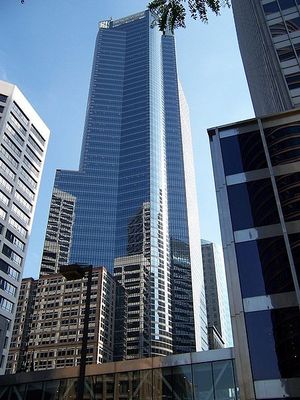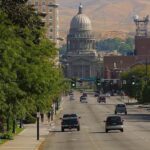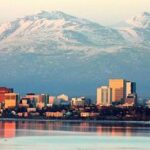This article, the twenty-third in a 50-state series, lists the twenty largest cities in Minnesota by population size and provides demographic details for each city: total population, population by age group, racial composition of the population, land area, and population density. For purposes of this article, cities are incorporated municipalities and census-designated places (CDPs).
After reading “Largest Cities in Minnesota (2011),” return to this link to read “Best Places to Live in Minnesota (2011).”
Similar articles for the remaining 49 states can be found at these links: Alabama, Alaska, Arizona, Arkansas, California, Colorado, Connecticut, Delaware, Florida, Georgia, Hawaii, Idaho, Illinois, Indiana, Iowa, Kansas, Kentucky, Louisiana, Maine, Maryland, Massachusetts, Michigan, Missouri, Mississippi, Montana, Nebraska, Nevada, New Hampshire, New Jersey, New Mexico, New York, North Carolina, North Dakota, Ohio, Oklahoma, Oregon, Pennsylvania, Rhode Island, South Carolina, South Dakota, Tennessee, Texas, Utah, Vermont, Virginia, Washington, West Virginia, Wisconsin, and Wyoming.
1. Largest Cities in Minnesota (2011): Minneapolis, MN
Located in the southeastern part of central Minnesota, Minneapolis is the largest city in the state with an estimated population of 382,578.
A comparatively large part of the population is college-aged: the city is home to the University of Minnesota. Grouped by age, 20.2% of the population is under 18, 15.1% is 18 to 24, 34.8% is 25 to 44, 21.9% is 45 to 64, and 8.0% is 65 or older. The median age of the population is 31.4.
The racial composition of the city is 63.8% White, 18.6% Black or African American, 2.0% Native American, 5.6% Asian, 5.6% from other races, and 4.4% from two or more races. The population is 10.5% Hispanic or Latino of any race.
The land area of the city is 54.9 square miles. The city’s population density is 6,969 people per square mile.
2. Largest Cities in Minnesota (2011): Saint Paul, MN
Situated in the southeastern part of central Minnesota, Saint Paul is the state’s capital and second largest city with an estimated population of 285,068.
Classified by age, 25.1% of the population is under 18, 13.8% is 18 to 24, 29.6% is 25 to 44, 22.6% is 45 to 64, and 8.9% is 65 or older. The median age of the population is 30.9.
The racial complexion of the city is 60.1% White, 15.7% Black or African American, 1.1% Native American, 15.0% Asian, 0.1% Pacific Islander, 3.9% from other races, and 4.2% from two or more races. The population is 9.6% Hispanic or Latino of any race.
The land area of the city is 52.8 square miles. The city’s population density is 5,399 people per square mile.
3. Largest Cities in Minnesota (2011): Rochester, MN
Located in southeastern Minnesota, Rochester is the third largest city in the state with an estimated population of 106,769.
Categorized by age, 25.1% of the population is under 18, 7.6% is 18 to 24, 29.4% is 25 to 44, 26.4% is 45 to 64, and 11.5% is 65 or older. The median age of the population is 38.3.
The racial profile of the city is 88.6% White, 3.7% Black or African American, 0.2% Native American, 5.5% Asian, 0.6% from other races, and 1.5% from two or more races. The population is 2.7% Hispanic or Latino of any race.
The land area of the city is 39.6 square miles. The city’s population density is 2,696 people per square mile.
4. Largest Cities in Minnesota (2011): Duluth, MN
Situated in northeastern Minnesota, Duluth is the fourth largest city in the state with an estimated population of 86,265.
A large part of the population is college-aged: the city is home to a number of colleges and universities, including the University of Minnesota Duluth (UMD) and its medical school. Sorted by age, 18.5% of the population is under 18, 19.6% is 18 to 24, 23.4% is 25 to 44, 24.8% is 45 to 64, and 13.7% is 65 or older. The median age of the population is 33.6.
The racial makeup of the city is 90.4% White, 2.3% Black or African American, 2.5% Native American, 1.5% Asian, 0.3% from other races, and 3.0% from two or more races. The population is 1.5% Hispanic or Latino of any race.
The land area of the city is 68.0 square miles. The city’s population density is 1,269 people per square mile.
5. Largest Cities in Minnesota (2011): Bloomington, MN
Located in the southeastern part of central Minnesota, Bloomington is the fifth largest city in the state with an estimated population of 82,893.
Arranged by age, 19.7% of the population is under 18, 7.8% is 18 to 24, 25.1% is 25 to 44, 28.9% is 45 to 64, and 18.5% is 65 or older. The median age of the population is 42.7.
The racial mix of the city is 79.7% White, 7.2% Black or African American, 0.4% Native American, 5.9% Asian, 0.1% Pacific Islander, 3.7% from other races, and 3.1% from two or more races. The population is 6.8% Hispanic or Latino of any race.
The land area of the city is 35.5 square miles. The city’s population density is 2,335 people per square mile.
6. Largest Cities in Minnesota (2011): Brooklyn Park, MN
Located in the southeastern part of central Minnesota, Brooklyn Park is the sixth largest city in the state with an estimated population of 75,781.
Grouped by age, 29.0% of the population is under 18, 9.4% is 18 to 24, 29.1% is 25 to 44, 24.7% is 45 to 64, and 7.8% is 65 or older. The median age of the population is 32.5.
The racial composition of the city is 52.2% White, 24.4% Black or African American, 0.5% Native American, 15.4% Asian, 0.1% Pacific Islander, 3.6% from other races, and 3.7% from two or more races. The population is 6.4% Hispanic or Latino of any race.
The land area of the city is 26.1 square miles. The city’s population density is 2,903 people per square mile.
7. Largest Cities in Minnesota (2011): Plymouth, MN
Situated in the southeastern part of central Minnesota, Plymouth is the seventh largest city in the state with an estimated population of 70,576.
Classified by age, 23.9% of the population is under 18, 6.8% is 18 to 24, 27.1% is 25 to 44, 30.1% is 45 to 64, and 12.1% is 65 or older. The median age of the population is 39.5.
The racial complexion of the city is 84.2% White, 5.2% Black or African American, 0.3% Native American, 6.9% Asian, 1.0% from other races, and 2.3% from two or more races. The population is 3.0% Hispanic or Latino of any race.
The land area of the city is 32.9 square miles. The city’s population density is 2,145 people per square mile.
8. Largest Cities in Minnesota (2011): St. Cloud, MN
Located in central Minnesota, St. Cloud is the eighth largest city in the state with an estimated population of 65,842.
A significant percentage of the population is college-aged: the city is home to St. Cloud State University. Categorized by age, 18.9% of the population is under 18, 23.8% is 18 to 24, 25.5% is 25 to 44, 21.5% is 45 to 64, and 10.3% is 65 or older. The median age of the population is 28.8.
The racial profile of the city is 84.6% White, 7.8% Black or African American, 0.7% Native American, 3.7% Asian, 0.8% from other races, and 2.5% from two or more races. The population is 2.4% Hispanic or Latino of any race.
The land area of the city is 30.2 square miles. The city’s population density is 2,180 people per square mile.
9. Largest Cities in Minnesota (2011): Eagan, MN
Situated in southeastern Minnesota, Eagan is the ninth largest city in the state with an estimated population of 64,206.
Sorted by age, 25.5% of the population is under 18, 7.9% is 18 to 24, 28.1% is 25 to 44, 30.9% is 45 to 64, and 7.6% is 65 or older. The median age of the population is 36.8.
The racial makeup of the city is 81.5% White, 5.6% Black or African American, 0.3% Native American, 7.9% Asian, 1.7% from other races, and 3.0% from two or more races. The population is 4.5% Hispanic or Latino of any race.
The land area of the city is 32.3 square miles. The city’s population density is 1,988 people per square mile.
10. Largest Cities in Minnesota (2011): Woodbury, MN
Located in southeastern Minnesota, Woodbury is the tenth largest city in the state with an estimated population of 61,961.
Arranged by age, 29.6% of the population is under 18, 6.2% is 18 to 24, 29.6% is 25 to 44, 26.3% is 45 to 64, and 8.3% is 65 or older. The median age of the population is 35.6.
The racial mix of the city is 81.4% White, 5.6% Black or African American, 0.3% Native American, 9.1% Asian, 1.0% from other races, and 2.5% from two or more races. The population is 3.8% Hispanic or Latino of any race.
The land area of the city is 35.0 square miles. The city’s population density is 1,770 people per square mile.
11. Largest Cities in Minnesota (2011): Maple Grove, MN
Located in the southeastern part of central Minnesota, Maple Grove is the eleventh largest city in the state with an estimated population of 61,567.
Grouped by age, 26.9% of the population is under 18, 6.3% is 18 to 24, 28.8% is 25 to 44, 30.7% is 45 to 64, and 7.3% is 65 or older. The median age of the population is 37.6.
The racial composition of the city is 86.4% White, 4.2% Black or African American, 0.3% Native American, 6.2% Asian, 0.8% from other races, and 2.2% from two or more races. The population is 2.5% Hispanic or Latino of any race.
The land area of the city is 32.9 square miles. The city’s population density is 1,871 people per square mile.
12. Largest Cities in Minnesota (2011): Coon Rapids, MN
Situated in the southeastern part of central Minnesota, Coon Rapids is the twelfth largest city in the state with an estimated population of 61,476.
Classified by age, 24.5% of the population is under 18, 8.8% is 18 to 24, 27.5% is 25 to 44, 27.8% is 45 to 64, and 11.4% is 65 or older. The median age of the population is 36.9.
The racial complexion of the city is 86.0% White, 5.5% Black or African American, 0.7% Native American, 3.5% Asian, 1.2% from other races, and 3.1% from two or more races. The population is 3.2% Hispanic or Latino of any race.
The land area of the city is 22.7 square miles. The city’s population density is 2,708 people per square mile.
13. Largest Cities in Minnesota (2011): Eden Prairie, MN
Located in the southeastern part of central Minnesota, Eden Prairie is the thirteenth largest city in the state with an estimated population of 60,797.
Categorized by age, 26.4% of the population is under 18, 6.6% is 18 to 24, 27.5% is 25 to 44, 30.8% is 45 to 64, and 8.6% is 65 or older. The median age of the population is 37.6.
The racial profile of the city is 81.7% White, 5.6% Black or African American, 0.2% Native American, 9.2% Asian, 1.0% from other races, and 2.3% from two or more races. The population is 3.0% Hispanic or Latino of any race.
The land area of the city is 32.4 square miles. The city’s population density is 1,876 people per square mile.
14. Largest Cities in Minnesota (2011): Burnsville, MN
Situated in southeastern Minnesota, Burnsville is the fourteenth largest city in the state with an estimated population of 60,306.
Sorted by age, 24.1% of the population is under 18, 8.9% is 18 to 24, 28.6% is 25 to 44, 26.7% is 45 to 64, and 11.7% is 65 or older. The median age of the population is 35.9.
The racial makeup of the city is 77.5% White, 10.0% Black or African American, 0.4% Native American, 5.0% Asian, 0.1% Pacific Islander, 3.5% from other races, and 3.5% from two or more races. The population is 7.9% Hispanic or Latino of any race.
The land area of the city is 24.9 square miles. The city’s population density is 2,422 people per square mile.
15. Largest Cities in Minnesota (2011): Blaine, MN
Located in the southeastern part of central Minnesota, Blaine is the fifteenth largest city in the state with an estimated population of 57,186.
Arranged by age, 26.5% of the population is under 18, 7.3% is 18 to 24, 30.7% is 25 to 44, 27.0% is 45 to 64, and 8.5% is 65 or older. The median age of the population is 35.6.
The racial mix of the city is 84.0% White, 3.7% Black or African American, 0.5% Native American, 7.8% Asian, 1.2% from other races, and 2.7% from two or more races. The population is 3.2% Hispanic or Latino of any race.
The land area of the city is 33.8 square miles. The city’s population density is 1,692 people per square mile.
16. Largest Cities in Minnesota (2011): Lakeville, MN
Located in southeastern Minnesota, Lakeville is the sixteenth largest city in the state with an estimated population of 55,954.
Grouped by age, 31.8% of the population is under 18, 6.6% is 18 to 24, 28.8% is 25 to 44, 27.0% is 45 to 64, and 5.8% is 65 or older. The median age of the population is 34.8.
The racial composition of the city is 89.3% White, 2.5% Black or African American, 0.4% Native American, 4.1% Asian, 1.2% from other races, and 2.5% from two or more races. The population is 3.5% Hispanic or Latino of any race.
The land area of the city is 36.2 square miles. The city’s population density is 1,546 people per square mile.
17. Largest Cities in Minnesota (2011): Minnetonka, MN
Situated in the southeastern part of central Minnesota, Minnetonka is the seventeenth largest city in the state with an estimated population of 49,734.
Classified by age, 20.8% of the population is under 18, 6.1% is 18 to 24, 23.2% is 25 to 44, 33.3% is 45 to 64, and 16.6% is 65 or older. The median age of the population is 45.0.
The racial complexion of the city is 90.0% White, 3.7% Black or African American, 0.3% Native American, 3.1% Asian, 0.7% from other races, and 2.1% from two or more races. The population is 2.4% Hispanic or Latino of any race.
The land area of the city is 27.1 square miles. The city’s population density is 1,835 people per square mile.
18. Largest Cities in Minnesota (2011): Apple Valley, MN
Located in southeastern Minnesota, Apple Valley is the eighteenth largest city in the state with an estimated population of 49,084.
Categorized by age, 25.4% of the population is under 18, 7.2% is 18 to 24, 27.5% is 25 to 44, 30.2% is 45 to 64, and 9.7% is 65 or older. The median age of the population is 37.9.
The racial profile of the city is 83.8% White, 5.5% Black or African American, 0.4% Native American, 5.3% Asian, 0.1% Pacific Islander, 2.0% from other races, and 3.0% from two or more races. The population is 4.9% Hispanic or Latino of any race.
The land area of the city is 17.3 square miles. The city’s population density is 2,837 people per square mile.
19. Largest Cities in Minnesota (2011): Edina, MN
Situated in the southeastern part of central Minnesota, Edina is the nineteenth largest city in the state with an estimated population of 47,941.
Sorted by age, 24.2% of the population is under 18, 4.6% is 18 to 24, 21.0% is 25 to 44, 29.6% is 45 to 64, and 20.6% is 65 or older. The median age of the population is 45.2.
The racial makeup of the city is 88.1% White, 3.0% Black or African American, 0.2% Native American, 6.1% Asian, 0.7% from other races, and 1.8% from two or more races. The population is 2.3% Hispanic or Latino of any race.
The land area of the city is 15.7 square miles. The city’s population density is 3,054 people per square mile.
20. Largest Cities in Minnesota (2011): St. Louis Park, MN
Located in the southeastern part of central Minnesota, St. Louis Park is the twentieth largest city in the state with an estimated population of 45,250.
Arranged by age, 18.5% of the population is under 18, 8.1% is 18 to 24, 36.4% is 25 to 44, 24.0% is 45 to 64, and 13.0% is 65 or older. The median age of the population is 35.4.
The racial mix of the city is 83.3% White, 7.5% Black or African American, 0.5% Native American, 3.8% Asian, 0.1% Pacific Islander, 1.8% from other races, and 3.1% from two or more races. The population is 4.3% Hispanic or Latino of any race.
The land area of the city is 10.7 square miles. The city’s population density is 4,229 people per square mile.
More Articles from J.C. Grant
“Average ACT Scores by State (2010)”
“Average SAT Scores by State (2010)”
“Largest U.S. Cities: Population Size (2011)”
“Most_Dangerous_Cities in America – Murder Rates”
State Education Rankings: Graduation Rates for High School, College, and Grad/Professional School
“State Education Rankings: SAT Scores”
Source(s):
“American Fact Finder,” U.S. Census Bureau
“Population, Housing Units, Area, and Density: 2000,” U.S. Census Bureau







